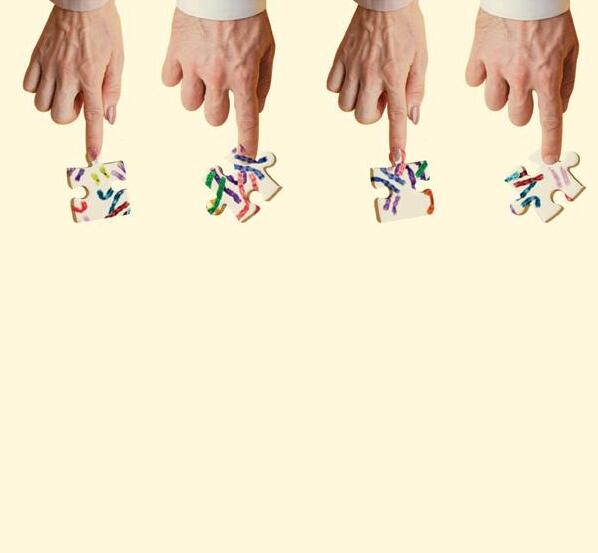
11 minute read
Bringing the Industry Together
Steve Brown, President of The Peanut Research Foundation, talks about ten years of scientific work for the development of the peanut sector worldwide.
// I understand that the major achievement of the Peanut Genome Initiative has been the sequencing of the DNA of both the wild and the commercial peanuts…
We’ve had two initiatives, really. The first was called the Peanut Genome Initiative, which was a five-year, $6-million investment by the industry. During those five years, we successfully sequenced the peanut genome. During the second phase, which we called Peanut Genome Initiative Phase Two, we focused on using these newfound tools for four research areas. The first was disease resistance, particularly leaf spot. The other areas were drought tolerance, aflatoxin mitigation and quality traits. Basically, what we’re pushing is this new technology called markerassisted selection. Back in 2012, when this work started, the industry leaders came together and decided that we were getting behind on breeding and we had to modernize it. At the same time people around the world were nervous about genetically modified organisms (GMOs), so with peanuts having a good reputation as a wholesome food, and being a kid’s food like peanut butter, the industry decided they didn’t want to try to market a GMO peanut, which I think was probably a wise decision at the time. Instead, we decided to use the genome to identify markers that breeders could employ in their breeding program. That would not lead to a GMO peanut but would facilitate breeding. So that’s what we’ve done. That has been the greatest accomplishment. There are more markers coming, and the breeders are putting them to work, gaining efficiency in their breeding process.

// From an organizational point of view, what would you say were the main challenges?

Well, just getting the industry together was a challenge. Getting everybody on the same page, to have a common goal took a little while. And that was done before my time, actually. Some of the industry leaders really jumped in there, made some phone calls, and said, “This is important. We’ve got to do this.” And then, of course, we must take into account that scientific research is a complex subject; it is hard to explain to somebody from the outside what exactly you’re doing. When you get proposals, research proposals from the scientist, they’re so technical and so hard for a layperson or a businessperson to really comprehend. So that’s always a challenge. Just trying to defend the decision on what projects you’re going to fund, and why this one is better than that one, has been quite a challenge. The foundation I work for, the Peanut Research Foundation, is an arm of the American Peanut Council, which is kind of an umbrella organization. There are many different peanut organizations, but this one includes everybody in the peanut industry: the manufacturers, the shellers, the growers, and all the allied industries as well. So, everybody comes together under that umbrella. We’re the arm that handles the research part of this sector. The board of directors I report to represents the entire industry; it’s a very diverse group and members have diverse needs. If you look at a manufacturer and ask, “What changes would you make to a peanut to make your product better?” he might say, “…Well, I want a more flavorful peanut, or I want one with more protein content in it.” The shellers might say, “I want one that shells easier, better shelling turnout.” The grower probably wants one with better disease resistance. So, each has different needs, and we had to convince everyone that not only is meeting your needs important to help you directly, but that when you help a grower to become more efficient and produce more peanuts, then it helps the entire industry and, indirectly, everybody benefits. So that’s been another challenge, and I think we’ve been successful in convincing people that, hey, you help one, you’re helping everybody.
// And what about the challenges from a scientific standpoint, if you had to mention a single issue that made the work of the initiative particularly difficult, what would it be?
When we first started this process, of course, we relied on some people with a lot of genetic expertise, and they warned us, “Hey, this isn’t going to be easy.” It took over a decade to figure out the human genome. It’s very complex, and the technology at that time was not like it is now; back then, it was very challenging. And when we started the peanut project, the methodology was still developing. Peanut is a tetraploid, which means it’s got four sets of chromosomes. This made it more complicated. Also, the peanut genome is very large; it has about 3 billion letters, about the same size as a human. It was always challenging, and it did take some tweaking. We went down some dead ends, and we had to back up and go a different route. But the technology available was improving. We started using new sequencing machines, and things just eventually fell into place. Eventually, also thanks to help from a company called HudsonAlpha, we managed to do the final assembly. You get these little snippets of the genome, you get little pieces, and then it’s like this huge jigsaw puzzle. You must put them all together in the right place. HudsonAlpha helped us do that. They told us at the time that it was probably the best tetraploid genome ever done at that point. It was really a high-quality outcome, and we were very pleased with the final product.

// An important aspect of the work is that the findings, the markers, are all published on the website peanutbase.org, and so it’s really available for all researchers and breeders. Was that a tough decision to make because ultimately the funding for the project came mainly from the industry…?
Yeah, that was discussed quite a bit, and there were two different angles: the first one is, “You keep it to yourself…It’s a competitive advantage and we paid for it, we’ll keep it.” But the other side was saying, “Well, we don’t really own it.” Besides we weren’t the exclusive funders of that research; there was funding coming from other sources, public funding from USDA, for example. And by the way, the original Peanut Genome Initiative was very international. We had scientists from all over the world participating. So, there was never a clear ownership. And I think the prevailing opinion, in the end, was that we don’t really own this intellectual property. If a private company had done this and they owned it, they would have clear ownership of the intellectual property and could charge for that technology. But we were opposed to that, nobody wanted to see their seed cost double because of some trait that was added in. So, if somebody discovers a marker, we publish it through regular publication, in a scientific journal. But then, once it’s published, it’s on the Peanut Base website. We encourage all the scientists we fund to get it into Peanut Base as soon as possible so that the finding is in the public domain and no private company can own that technology. In terms of competitive advantage, you must also consider that traits vary according to geographical regions. Even here in the United States, a variety that does well in the southeastern US, where I am, does not do well in West Texas, and vice versa. Just because you have a marker for a trait, your work has just begun to get it into a variety that works for your area.
// Talking about international cooperation, I remember the meeting of the initiative in Argentina in 2017. There were researchers and scientists from China, India, and all the other peanut-producing countries. I imagine that must have been a challenge as well, getting so many professionals from different places to agree on things…

Nevertheless, it worked amazingly well. There were some glitches, of course, but it was a pretty cooperative group. Sometimes scientists tend to want to keep their cards to themselves and get credit for what they do, which is fine. But in this initiative, we said, “Okay, we have a common goal, you do this, I’ll do that, then let’s get back together and talk about it, and we’ll make a decision on which way to go.” That really happened. We had scientists from all over the world that took on different parts of this huge task and would report back what they found. In the end, the senior author for the final genome paper was Josh Clevenger from the US, but there were like 35 or 40 additional authors from all over the world. I wouldn’t say there was no jealousy at all, but amazingly there was very good cooperation.
// That’s good to hear. How do you assess the current situation in terms of international cooperation on peanut science?
I guess I’d have to say that the international group has kind of disbanded. I mean, there’s still collaboration on specific projects, people work with each other, but that particular entity is not there anymore. That doesn’t mean there can’t be collaboration, there is, but not across the board like it was. The international meetings were called AAGB, Advances in Arachis Genomics and Biotechnology. We funded those meetings for several years; we were having them annually and moved them all over the world. When COVID hit, we stopped, and, for three or four years in a row, we had no international meetings. But we are starting back up again this year. It is going to be at the HudsonAlpha building, the company I told you about, the one that helped us assemble the genome. It is a research institute in Huntsville, Alabama, and they’re going to host the AAGB meeting this coming October. I’m sure there’ll be people coming from all over the world to participate. So, the collaboration is still there, and I hope it continues.
// Of course, Aflatoxin for peanuts is a worldwide problem. How do you assess the status of the work on aflatoxin resistance? Can we be optimistic going forward?
The prevailing opinion of the scientists, back several years ago, when we started this, was that we had to control our expectations. They would say: “Look, some things are going to be easier than others.” We think we can do a pretty good job with some disease resistance, particularly, by the way, using some of the wild species. But they warned us that there were some traits that would be very difficult, if at all possible, and aflatoxin was one of those. Of course, aflatoxin is produced by the fungus, not by the plant. So, to make a change in the plant that would affect aflatoxin production is really a challenge. In time we’ve learned more and more about aflatoxin, but we really have gotten almost nowhere in terms of solving the problem. So recently, in my opinion, the genomic work that’s been done has provided some of the most optimistic data that I’ve seen in a long time. We’re certainly not telling anybody that we can make aflatoxin go away with genomics, but we do now have a couple of markers for areas on the peanut genome that control what happens with that fungal interaction. The interaction is a delicate dance between a fungus and a plant. Under certain stress conditions, the plant sends out a signal, the fungus responds, the plant responds with a defense mechanism, and then the fungus overcomes that. It’s back and forth. It’s a very complex metabolic system that’s going on and we are just starting to understand. But there are certain genes within the peanut plant that can help that metabolic signaling that goes on. Some of our researchers have found some of those markers. We don’t know yet how important they are, how much of the variation in aflatoxin and contamination is controlled by those markers, and there are many other factors going on, but it’s under testing right now. We have at least one breeder that’s already got it in his breeding program. He’s looking at it, trying to find varieties that will be less conducive to aflatoxin. It’s very encouraging to me that there’s finally a path that we think might make some headway.
// Before you mentioned GMOs. Many people believe that GMOs can indeed bring many advantages to peanut production and consumption. In this case, the challenges can be considered more and more in terms of public relations than strictly scientific research. What do you think?
I think it’s going to take some time. Yes, you’re right, it’s a marketing issue more than a scientific one. I don’t know of a single scientist that thinks there’s anything harmful in a GMO peanut or a GMO anything. But when it comes down to marketing, there is a negative perception. I don’t see the industry saying, yeah, give me a GMO peanut right now. I doubt that can happen. But there’s another issue: gene editing. GMO means that you’re taking genes from another totally different organism, and you’re bringing them into the peanut, or soybean, or corn plant. All this is very common, of course, with the major acreage crops. Cotton, for example, has BT cotton, which uses genes from a bacteria; it produces a toxin to repel certain insects. Those types of traits come from other organisms. Gene editing is when you actually alter a gene that already exists in the species. You can make a tweak on that gene and possibly turn it off, or turn it on, to create some new trait. Maybe this procedure can be a little more palatable to the public. Although some are still wary of gene editing as well. The European Union has been the one area with stricter standards on this issue. But from what I read, the European Union is at least considering gene editing as being something they could accept. It’s not official yet, but I see that coming down the road. Maybe the pressure will mount and the scientific evidence will demonstrate that these things are safe. When? I don’t know. But a lot of crops are already investing heavily in gene editing, and there are some amazing things that are being done. The fear is that maybe we’re getting a little behind in peanut. Maybe we’re being too conservative and need to be investing, so we can be ready to deploy some of this gene editing technology when the time is right.

// Is there anything you would like to add about the initiative going forward?
Well, one thing is that we really want input on how to go forward. We are actively seeking input from our members, from the US peanut industry. But I would welcome input from the rest of the world as well. Another important issue for the future, for example, is the traceability and segregation of peanuts. As we develop more and more sophisticated peanut varieties that have certain traits, the product gets diversified. We realize that there will never be one variety of peanut, the variety depends on what the market wants. So if we’re successful in all these breeding programs and we come up with really improved varieties for different markets, then all of a sudden, we will have maybe a slate of six or eight different peanuts out there, different varieties that are going to different markets. That means more segregation. And that scares the heck out of the shellers because they’re already having to segregate high-oleic peanuts from non-high-oleic for their customers, who don’t want to mix them. This is going to be an important issue as we become more successful in peanut breeding. That means we’re going to have to keep all these things separate for the different markets. Just another thing to keep in mind.







